Flexibility Assessment of Multi-Energy Residential and Commercial Buildings
Abstract
1. Introduction
1.1. Motivation and Aim
1.2. Literature Review
1.3. Contributions and Advantages of the Proposed Model
1.4. Paper Organization
2. Problem and Model Description
2.1. System Operator
2.2. Energy Hub
2.3. Energy Hub Management System
- Spaces temperature set points and flexibility bands;
- Hot water temperature and flexibility band;
- Refrigeration systems temperatures and flexibility bands;
- Profiles of electrical equipment, lighting and cooking;
- Lighting flexibility bands;
- EVs connection and disconnection hours;
- Final SOC of the EVs.
3. Model Constraints
3.1. Objective Function
3.2. Network Constraints
3.2.1. Power Flow Constraints
3.2.2. Generator Units Constraints
3.3. Energy Hub Modelling Constraints
3.3.1. Load
3.3.2. Energy Hub Inputs
3.3.3. Energy Hub Outputs
3.3.4. Energy Converters and Storage Systems Input
3.3.5. Energy Resources Output
3.4. Load, EVs, Storage and PV Contraints
3.4.1. Thermal Model
3.4.2. HVAC System
3.4.3. Thermostats
3.4.4. Water Heating
3.4.5. Refrigeration
3.4.6. Other Loads
3.4.7. Electric Vehicles
3.4.8. Storage Systems
3.4.9. PVs
4. Case Study and Results
4.1. Case Study Description
- First, the percentage of coal and natural gas in the electricity generation mix is determined, defining a daily profile for each of these resources;
- Then, the daily profiles are multiplied by the CO emissions market price for that day and by a factor representing the total emissions of each resource per MWh of generated electricity.
4.2. Results
- Only electrical buildings without optimization (no DR);
- Only electrical buildings with optimization (with DR);
- MES buildings without optimization (no DR);
- MES buildings with optimization (with DR).
- In Section 4.2.1, grid technical problems occurring in 7 January 2019 are analyzed;
- In Section 4.2.2, the daily load profiles of the proposed cases are studied;
- In Section 4.2.3 and Section 4.2.4, the flexibility that only-electrical vs. MES buildings and commercial vs. residential buildings are able to offer for that day is analyzed;
- In Section 4.2.5, it is studied how the flexibility provided by the different resources and loads are used to mitigate voltage problems;
- Finally, Section 4.2.6 presents the annual results for energy consumption, CO emissions and costs.
4.2.1. Grid Technical Problems
4.2.2. Daily Load Diagrams
4.2.3. Flexibility of Only Electrical and MES Buildings
4.2.4. Flexibility of Residential and Commercial Buildings
4.2.5. Impact on the Daily Load Profiles of Flexible Loads
- HVAC system is always “on”;
- Between 6 h and 23 h:
- -
- The temperature set-point is 21 C;
- -
- The temperature can vary between 15 C and 25 C.
- Between 0 h and 6 h and after 23 h:
- -
- There is no set-point;
- -
- The temperature can vary between 15 C and 25 C.
- The temperature is set to −5C for the entire day;
- The temperature can vary between −6 C and −3 C by using the DR program.
- The temperature is set to 49 C for the entire day;
- The temperature can vary between 44 C and 54 C by using the DR program.
4.2.6. Annual Results
5. Conclusions
Author Contributions
Funding
Conflicts of Interest
Abbreviations
| P | Active power [kWh] |
| Q | Reactive power [kVar] |
| I | Current [A] |
| V | Voltage [V] |
| v | Volume [m] |
| r | Resistance [] |
| R | Thermal resistance [C/kW] |
| x | Reactance [] |
| X | Thickness of the walls [m] |
| Temperature of the room [C] | |
| Thermal constant () | |
| Infiltration rate [air changes per hour—ACH] | |
| l | Heat gain and losses [C] |
| C | Thermal capacitance [kWh/C] |
| c | Specific heat capacity [J/g·C] |
| Volumetric heat capacity [kJ/mC] | |
| k | Thermal conductivity of the material [kW/m·C] |
| A | Area [m] |
| a | Insulation [kWh/C] |
| d | Density of the materials of the walls [] |
| m | Supply air flow rate [cfm, cubic feet per minute] |
| Efficiency [%] | |
| Coefficient of performance | |
| System inertia | |
| L | Load |
| b | Binary variable |
| State-of-charge | |
| E | Energy flow between resources [kWh] |
| I | Energy input of the energy hub [kWh] |
| O | Energy output of the energy hub [kWh] |
| Price [€ /kWh] or [€/C] | |
| Cost [€] | |
| Subscripts | |
| t | Time interval |
| Item belonging to a set | |
| t | Time interval |
| 0 | Initial time |
| Wind generator | |
| PV generator | |
| O | Outside |
| h | Heating vector |
| c | Cooling vector |
| g | Gas vector |
| w | Electricity vector |
| C | Discharge |
| Consumer | |
| Demand response | |
| Increase, decrease | |
| Air | |
| Superscripts | |
| Infiltration | |
| Wall | |
| Coil | |
| Fan | |
| Water | |
| Refrigeration system | |
| Electrical equipment | |
| Cooking | |
| Lighting | |
| Input | |
| Output | |
| Electrical vehicle | |
| Storage system | |
| Network | |
| Charging | |
| Discharging | |
| Network | |
| Voltage violation | |
| Carbon dioxide | |
| Sets | |
| Electrical network load | |
| Electrical network bus | |
| Electrical network wind generator | |
| Electrical network PV | |
| R | Energy hub room |
| N | Energy hub network |
| C | Energy hub converter |
| S | Energy hub storage |
| L | Energy hub load |
| x | Energy hub EV |
| Energy hub PV | |
| M | Fan supply air flow values |
| Symbols | |
| Parameter defined by consumer | |
| Maximum, minimum |
Appendix A. Parameters of the Models
| Parameter | Description | Value |
|---|---|---|
| Specific heat capacity of air | 1.09 J/g·C | |
| Efficiency of heating coil | 0.98 | |
| Efficiency of cooling coil | 0.98 | |
| COP of heating coil | 3.45 | |
| COP of cooling coil | 4.45 | |
| Discharging cooling air temperature | 12.5 C | |
| Discharging heating air temperature | 50 C | |
| Parameter 1 of the fan model | ||
| Parameter 2 of the fan model | ||
| Parameter 3 of the fan model | ||
| Parameter 4 of the fan model | ||
| Specific heat capacity of water | 4.18 J/g·C | |
| Initial temperature of water | 15 C | |
| COP of refrigeration systems | 3 | |
| a (Residential) | Insulation of residential refrigeration systems | 15 kJ/C |
| a (Supermarket) | Insulation of supermarket refrigeration systems | 850 kJ/C |
Appendix B. Average Values Per Month

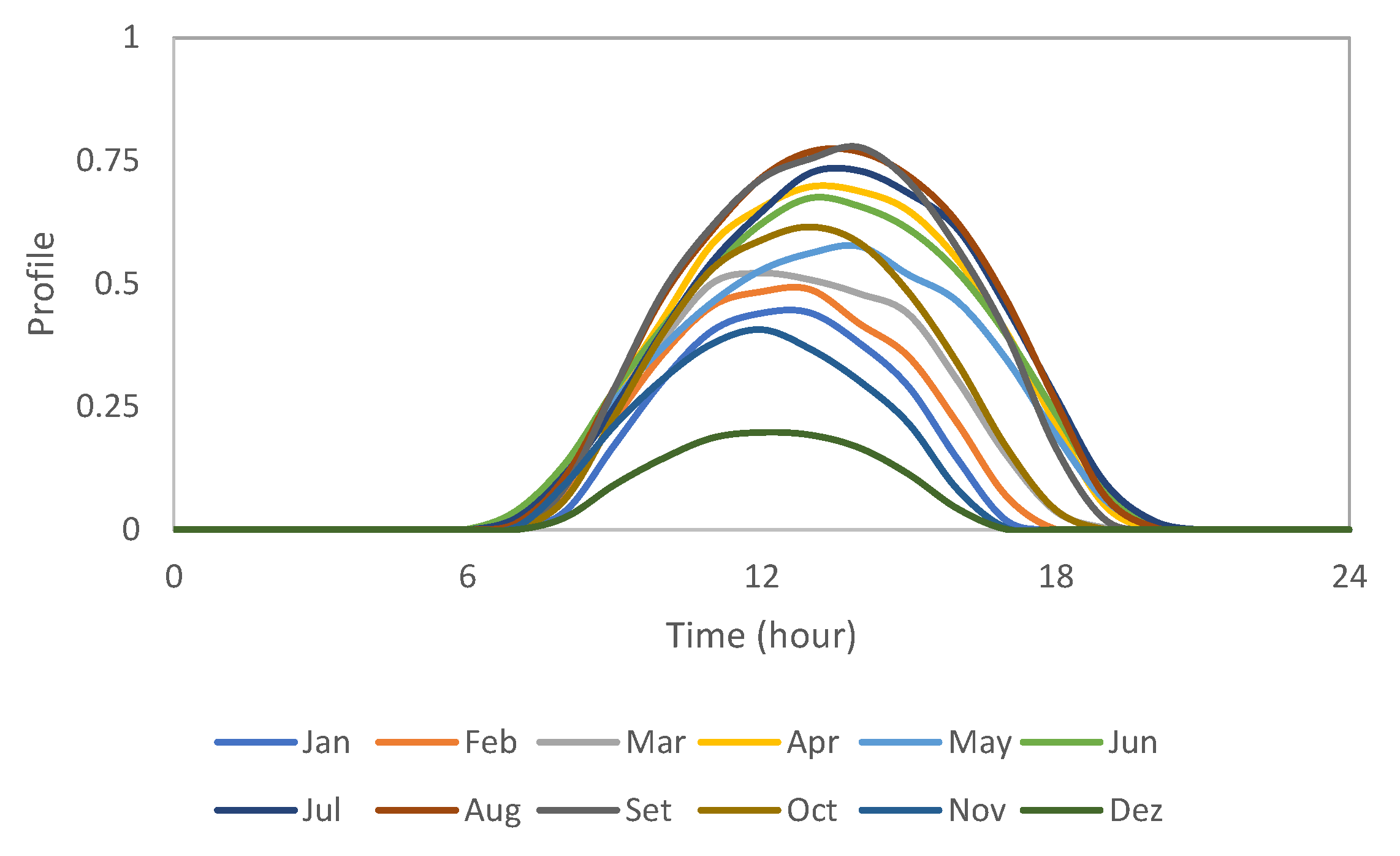

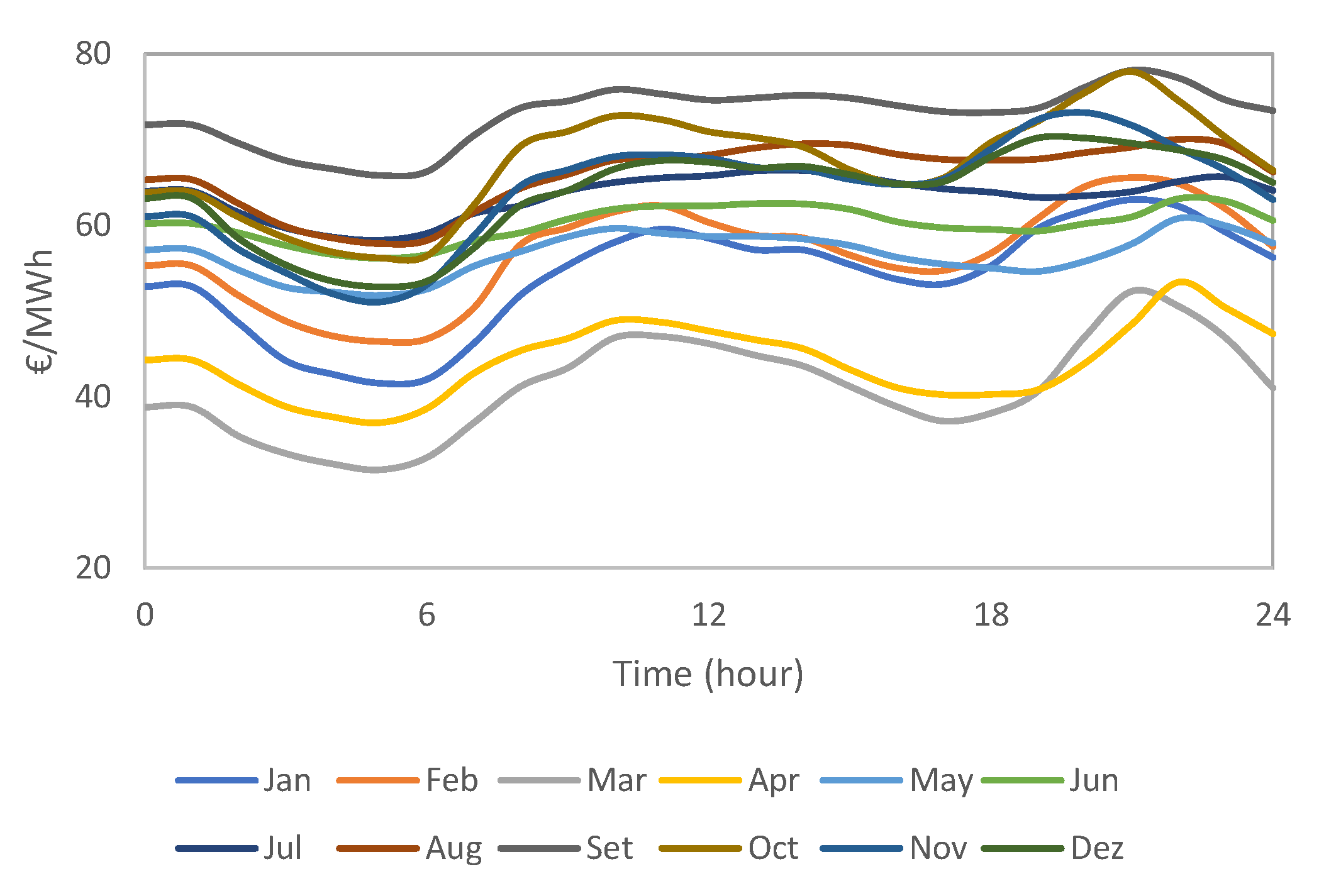
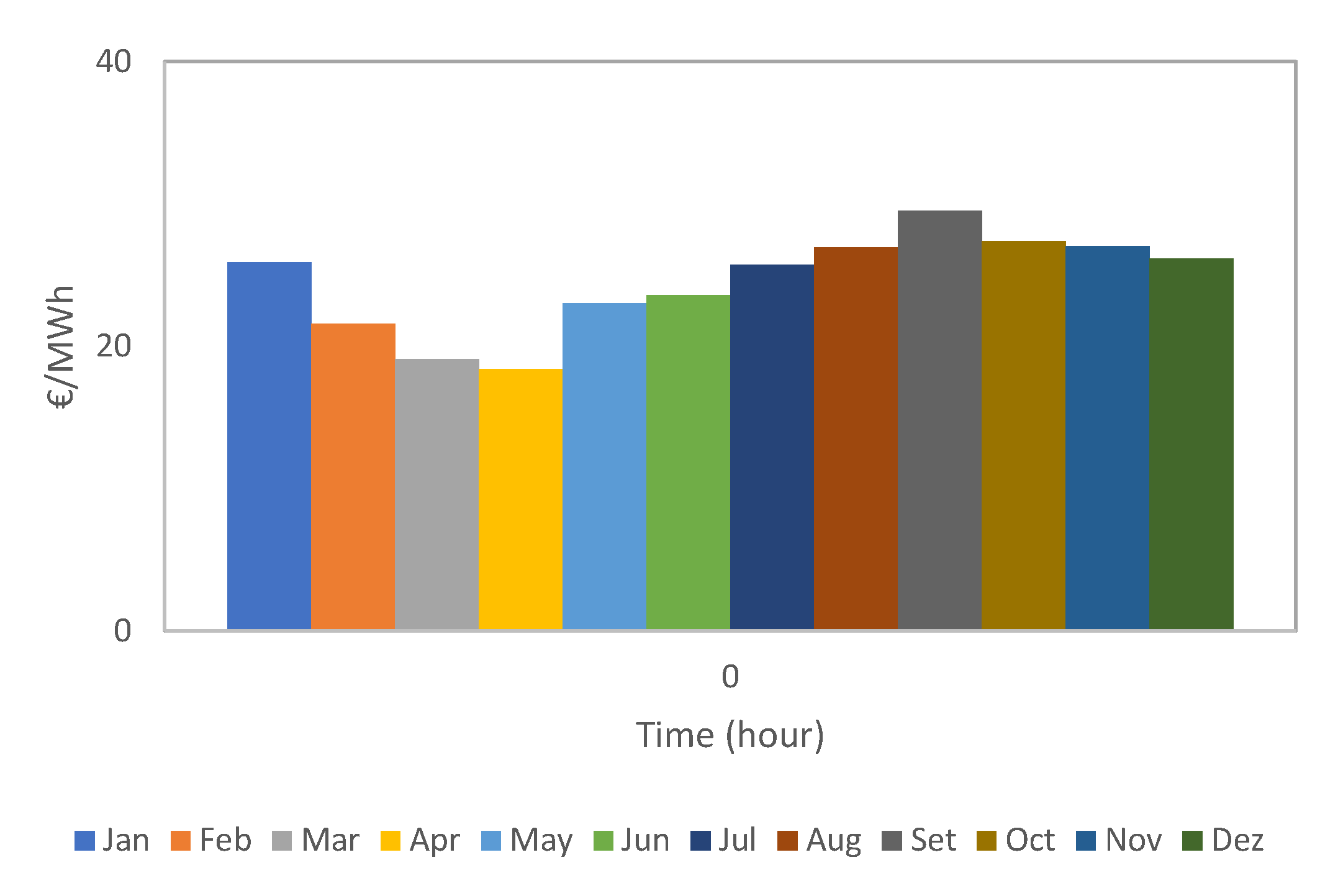

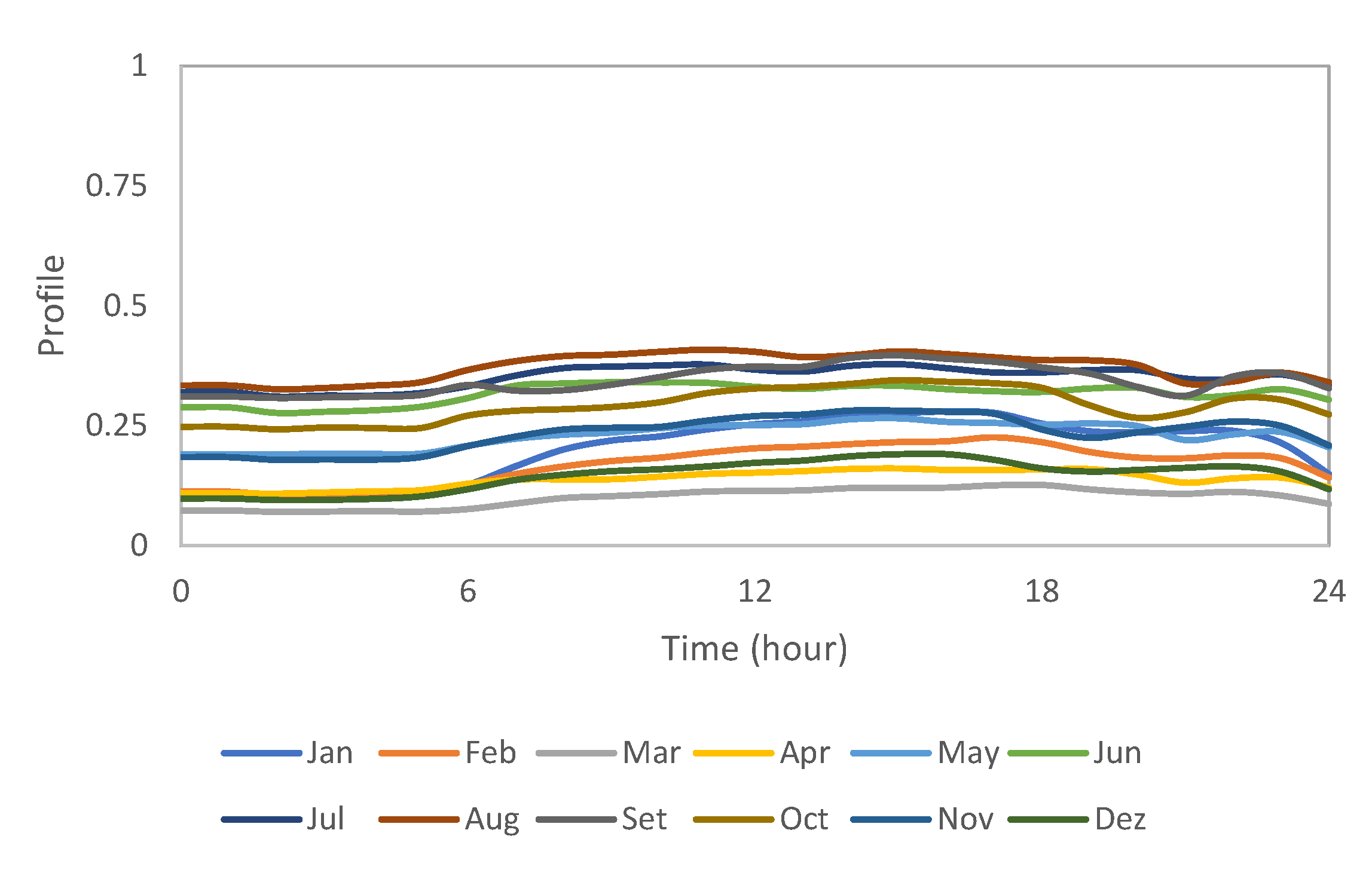

References
- Agency, I.E. CO2 Emissions from Fuel Combustion: Overview; International Energy Agency (IEA): Paris, France, 2018. [Google Scholar]
- Agency, I.E. Renewables 2017: Analysis and Forecasts to 2022; Technical Report; International Energy Agency (IEA): Paris, France, 2017. [Google Scholar]
- Coelho, A.; Neyestani, N.; Soares, F.; Lopes, J.P. Wind variability mitigation using multi-energy systems. Int. J. Electr. Power Energy Syst. 2020, 118, 105755. [Google Scholar] [CrossRef]
- Geidl, M.; Koeppel, G.; Favre-Perrod, P.; Klöckl, B.; Andersson, G.; Fröhlich, K. The Energy Hub—A Powerful Concept for Future Energy Systems. In Proceedings of the Third Annual Carnegie Mellon Conference on the Electricity Industry, Pittsburgh, PA, USA, 13–14 March 2007; pp. 13–14. [Google Scholar]
- Wang, Y.; Zhang, N.; Kang, C.; Kirschen, D.S.; Yang, J.; Xia, Q. Standardized Matrix Modeling of Multiple Energy Systems. IEEE Trans. Smart Grid 2017, 10, 257–270. [Google Scholar] [CrossRef]
- Wang, Y.; Cheng, J.; Zhang, N.; Kang, C. Automatic and linearized modeling of energy hub and its flexibility analysis. Appl. Energy 2017, 211, 705–714. [Google Scholar] [CrossRef]
- Gimelli, A.; Muccillo, M.; Sannino, R. Optimal design of modular cogeneration plants for hospital facilities and robustness evaluation of the results. Energy Convers. Manag. 2017, 134, 20–31. [Google Scholar] [CrossRef]
- Mohiuddin, S.; Mahmud, M.; Haruni, A.; Pota, H. Design and implementation of partial feedback linearizing controller for grid-connected fuel cell systems. Int. J. Electr. Power Energy Syst. 2017, 93, 414–425. [Google Scholar] [CrossRef]
- Mukherjee, U.; Walker, S.; Maroufmashat, A.; Fowler, M.; Elkamel, A. Development of a pricing mechanism for valuing ancillary, transportation and environmental services offered by a power to gas energy system. Energy 2017, 128, 447–462. [Google Scholar] [CrossRef]
- Wasilewski, J. Integrated modeling of microgrid for steady-state analysis using modified concept of multi-carrier energy hub. Int. J. Electr. Power Energy Syst. 2015, 73, 891–898. [Google Scholar] [CrossRef]
- Moeini-Aghtaie, M.; Abbaspour, A.; Fotuhi-Firuzabad, M.; Dehghanian, P. Optimized Probabilistic PHEVs Demand Management in the Context of Energy Hubs. IEEE Trans. Power Deliv. 2015, 30, 996–1006. [Google Scholar] [CrossRef]
- Yazdani-Damavandi, M.; Moghaddam, M.P.; Haghifam, M.R.; Shafie-khah, M.; Catalao, J.P.S. Modeling Operational Behavior of Plug-in Electric Vehicles’ Parking Lot in Multienergy Systems. IEEE Trans. Smart Grid 2016, 7, 124–135. [Google Scholar] [CrossRef]
- Li, Z.; Wu, W.; Wang, J.; Zhang, B.; Zheng, T. Transmission-Constrained Unit Commitment Considering Combined Electricity and District Heating Networks. IEEE Trans. Sustain. Energy 2016, 7, 480–492. [Google Scholar] [CrossRef]
- Moeini-Aghtaie, M.; Abbaspour, A.; Fotuhi-Firuzabad, M.; Hajipour, E. A Decomposed Solution to Multiple-Energy Carriers Optimal Power Flow. IEEE Trans. Power Syst. 2013, 29, 707–716. [Google Scholar] [CrossRef]
- Dzobo, O.; Xia, X. Optimal operation of smart multi-energy hub systems incorporating energy hub coordination and demand response strategy. J. Renew. Sustain. Energy 2017, 9, 045501. [Google Scholar] [CrossRef]
- Hao, H.; Corbin, C.D.; Kalsi, K.; Pratt, R.G. Transactive Control of Commercial Buildings for Demand Response. IEEE Trans. Power Syst. 2017, 32, 774–783. [Google Scholar] [CrossRef]
- Vrettos, E.; Andersson, G. Scheduling and Provision of Secondary Frequency Reserves by Aggregations of Commercial Buildings. IEEE Trans. Sustain. Energy 2016, 7, 850–864. [Google Scholar] [CrossRef]
- Iria, J.; Soares, F.; Matos, M. Optimal bidding strategy for an aggregator of prosumers in energy and secondary reserve markets. Appl. Energy 2019, 238, 1361–1372. [Google Scholar] [CrossRef]
- Iria, J.P.; Soares, F.J.; Matos, M.A. Trading Small Prosumers Flexibility in the Energy and Tertiary Reserve Markets. IEEE Trans. Smart Grid 2018, 10, 2371–2382. [Google Scholar] [CrossRef]
- Lemmer, E.F.; Delport, G.J. The influence of a variable volume water heater on the domestic load profile. IEEE Trans. Energy Convers. 1999, 14, 1558–1563. [Google Scholar] [CrossRef]
- Mendes, L.A.; Freire, R.Z.; Coelho, L.d.S.; Moraes, A.S. Minimizing computational cost and energy demand of building lighting systems: A real time experiment using a modified competition over resources algorithm. Energy Build. 2017, 139, 108–123. [Google Scholar] [CrossRef]
- Stadler, M.; Krause, W.; Sonnenschein, M.; Vogel, U. Modelling and evaluation of control schemes for enhancing load shift of electricity demand for cooling devices. Environ. Model. Softw. 2009, 24, 285–295. [Google Scholar] [CrossRef]
- Lopes, J.A.; Soares, F.J.; Almeida, P.M. Integration of electric vehicles in the electric power system. Proc. IEEE 2011, 99, 168–183. [Google Scholar] [CrossRef]
- Vrettos, E.; Kara, E.C.; MacDonald, J.; Andersson, G.; Callaway, D.S. Experimental Demonstration of Frequency Regulation by Commercial Buildings—Part I: Modeling and Hierarchical Control Design. IEEE Trans. Smart Grid 2018, 9, 3213–3223. [Google Scholar] [CrossRef]
- Mohammad, N.; Rahman, A. Transactive control of industrial heating–ventilation–air-conditioning units in cold-storage warehouses for demand response. Sustain. Energy Grids Netw. 2019, 18, 100201. [Google Scholar] [CrossRef]
- Yudong, M.; Borrelli, F. Fast stochastic predictive control for building temperature regulation. In Proceedings of the 2012 American Control Conference (ACC), Montreal, QC, Canada, 27–29 June 2012; pp. 3075–3080. [Google Scholar] [CrossRef]
- Iria, J.; Soares, F. A cluster-based optimization approach to support the participation of an aggregator of a larger number of prosumers in the day-ahead energy market. Electr. Power Syst. Res. 2019, 168, 324–335. [Google Scholar] [CrossRef]
- Baran, M.; Wu, F. Optimal sizing of capacitors placed on a radial distribution system. IEEE Trans. Power Deliv. 1989, 4, 735–743. [Google Scholar] [CrossRef]
- Baran, M.; Wu, F. Optimal capacitor placement on radial distribution systems. IEEE Trans. Power Deliv. 1989, 4, 725–734. [Google Scholar] [CrossRef]
- Gan, L.; Low, S.H. Convex relaxations and linear approximation for optimal power flow in multiphase radial networks. In Proceedings of the 2014 Power Systems Computation Conference, PSCC 2014, Wroclaw, Poland, 18–22 August 2014. [Google Scholar] [CrossRef]
- Yeh, H.G.; Gayme, D.F.; Low, S.H. Adaptive VAR control for distribution circuits with photovoltaic generators. IEEE Trans. Power Syst. 2012, 27, 1656–1663. [Google Scholar] [CrossRef]
- Melby, P.; Cathcart, T. Regenerative Design Techniques: Practical Applications in Landscape Design; Wiley: Hoboken, NJ, USA, 2002; p. 410. [Google Scholar]
- Nicklas, S. ASHRAE Handbook HVAC Systems and Equipment; Technical Report 28; American Society of Heating, Refrigerating and Air-Conditioning Engineers (ASHRAE): Atlanta, GE, USA, 2016. [Google Scholar]
- Park, S.Y.; Cho, S.; Ahn, J. Improving the quality of building spaces that are planned mainly on loads rather than residents: Human comfort and energy savings for warehouses. Energy Build. 2018, 178, 38–48. [Google Scholar] [CrossRef]
- Ryder-Cook, D.; Mackay, D. Thermal Modelling of Buildings. Available online: https://inference.org.uk/is/papers/DanThermalModellingBuildings.pdf (accessed on 14 February 2019).
- Commercial Reference Buildings|Department of Energy. Available online: https://www.energy.gov/eere/buildings/new-construction-commercial-reference-buildings (accessed on 11 April 2019).
- Kelman, A.; Borrelli, F. Bilinear Model Predictive Control of a HVAC System Using Sequential Quadratic Programming. IFAC Proc. Vol. 2011, 44, 9869–9874. [Google Scholar] [CrossRef]
- Meteogalicia. Datos Históricos das redes de Estacións. Available online: https://www.meteogalicia.gal/web/inicio.action (accessed on 11 April 2019).
- ENTSOE. Day-Ahead Prices. Available online: https://transparency.entsoe.eu/transmission-domain/r2/dayAheadPrices/show (accessed on 27 August 2019).
- MIBGAS (Mercado Ibérico del Gas). Datos Gas. Available online: http://www.mibgas.es/pt/mercados-gas (accessed on 27 August 2019).
- Insider, M. CO2 European Emission Allowances. Available online: https://markets.businessinsider.com/commodities/co2-european-emission-allowances (accessed on 16 May 2020).
- Quaschning, V. Regenerative Energiesysteme Technologie, Berechnung, Klimaschutz; Hanser: Munich, Germany, 2019. [Google Scholar]
- REN. Produção Verificada—Sistema de Informação de Mercados de Energia. Available online: http://www.mercado.ren.pt/PT/Electr/InfoMercado/Prod/Paginas/Verificada.aspx (accessed on 16 May 2020).
- U.S. Energy Information Administration. Monthly Energy Review; Technical Report; U.S. Energy Information Administration (EIA): Washington, DC, USA, 2020.
- PyCharm: The Python IDE for Professional Developers by JetBrains. Available online: https://www.jetbrains.com/pycharm/ (accessed on 19 March 2019).
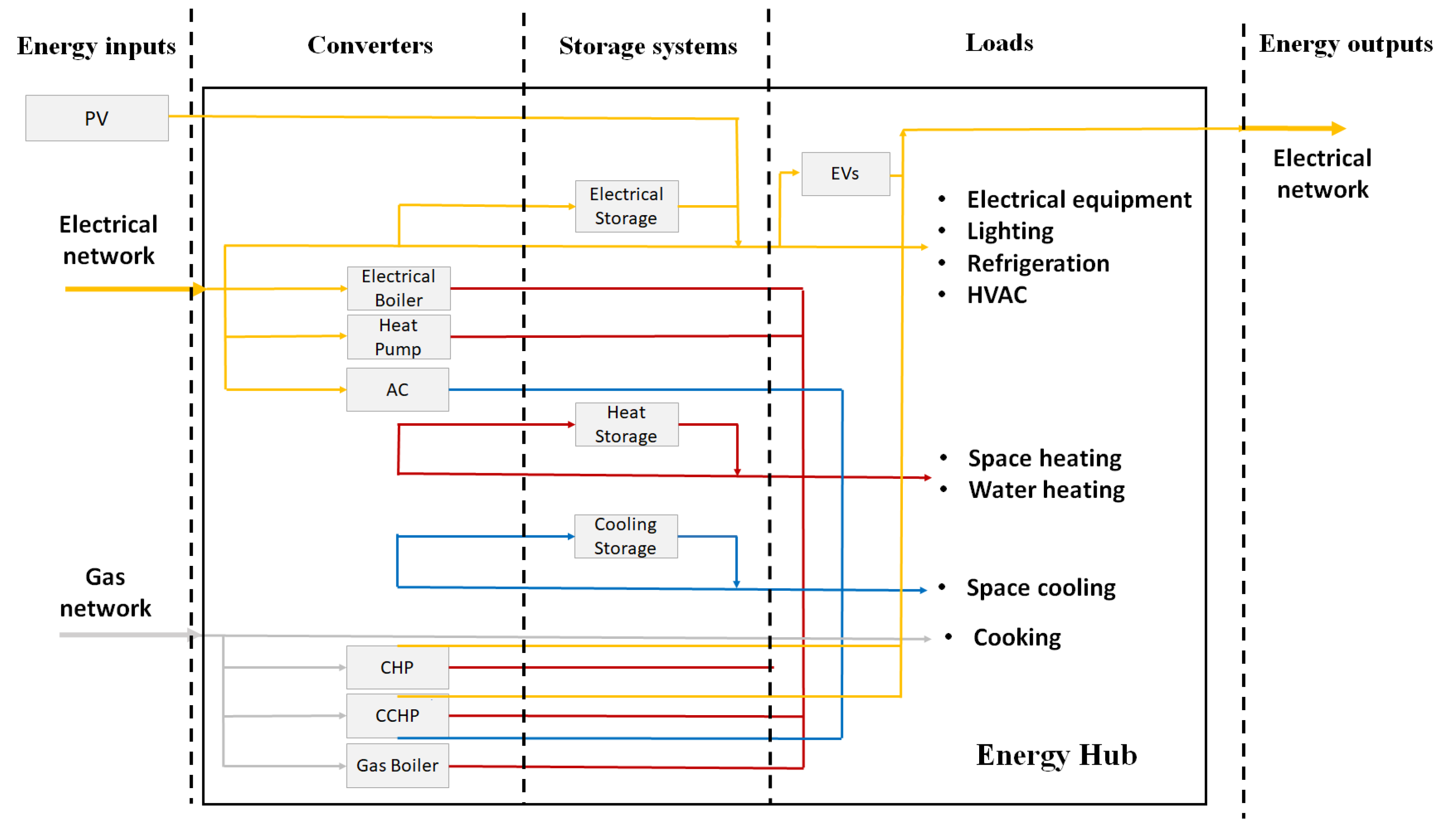
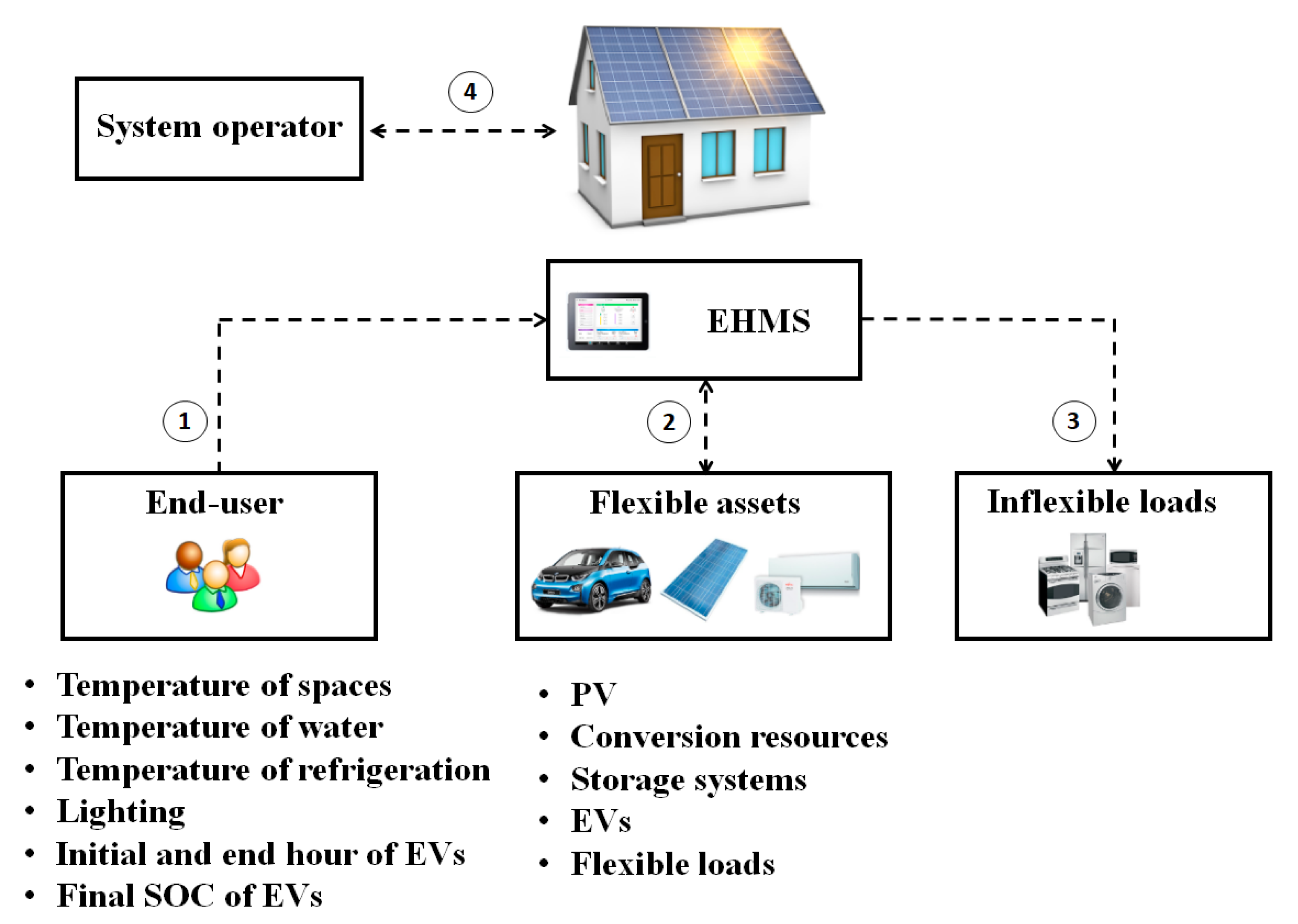


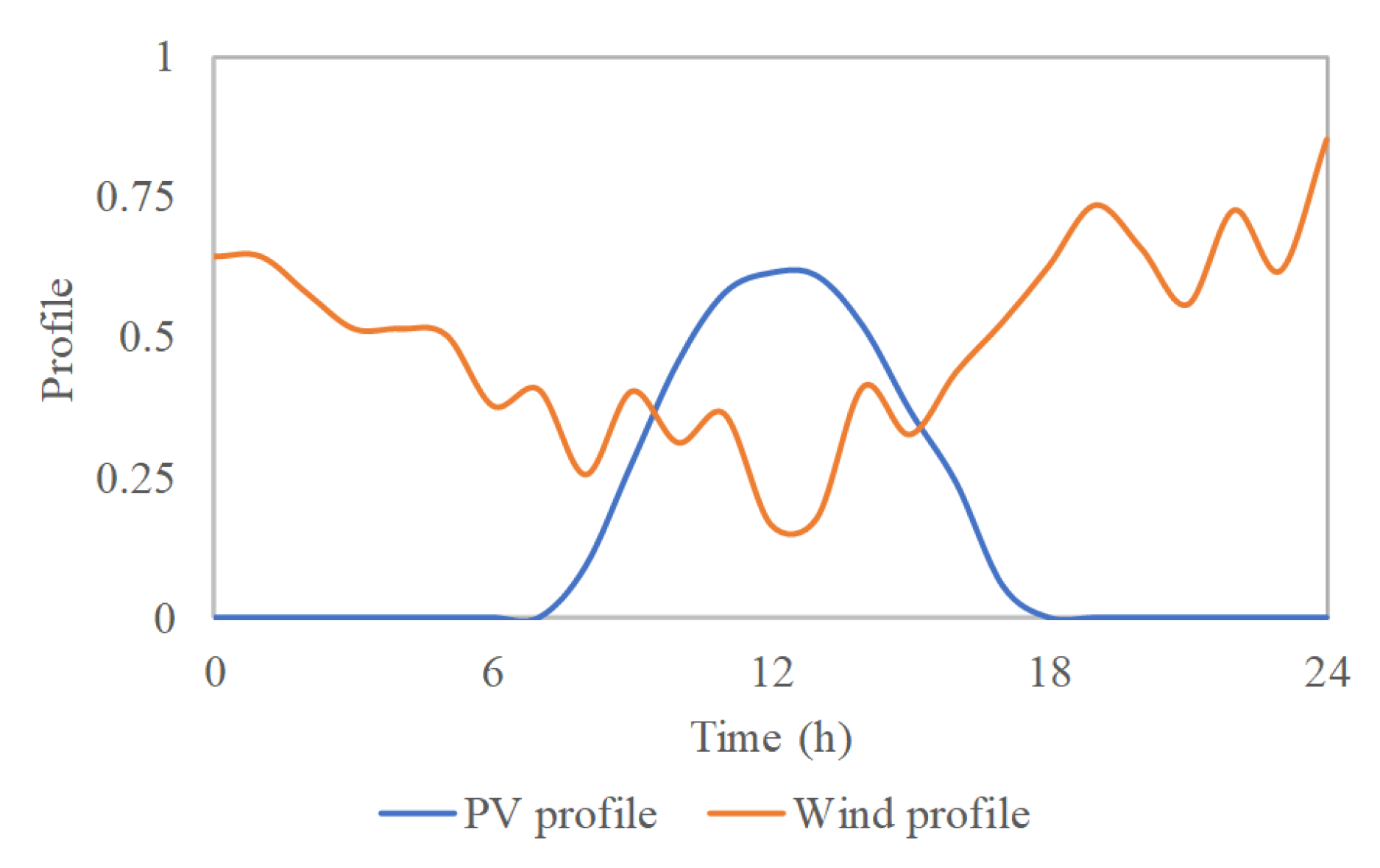
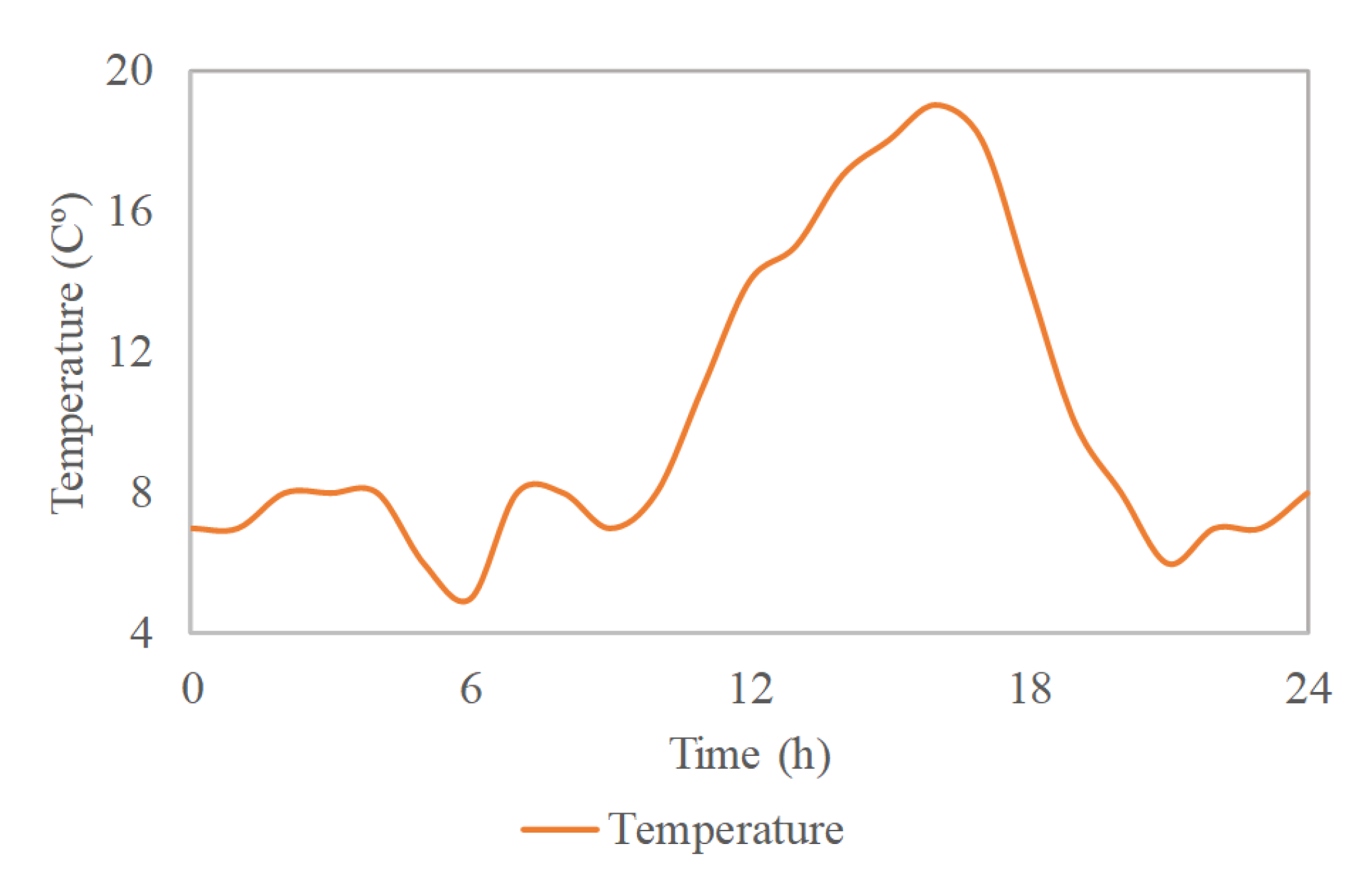
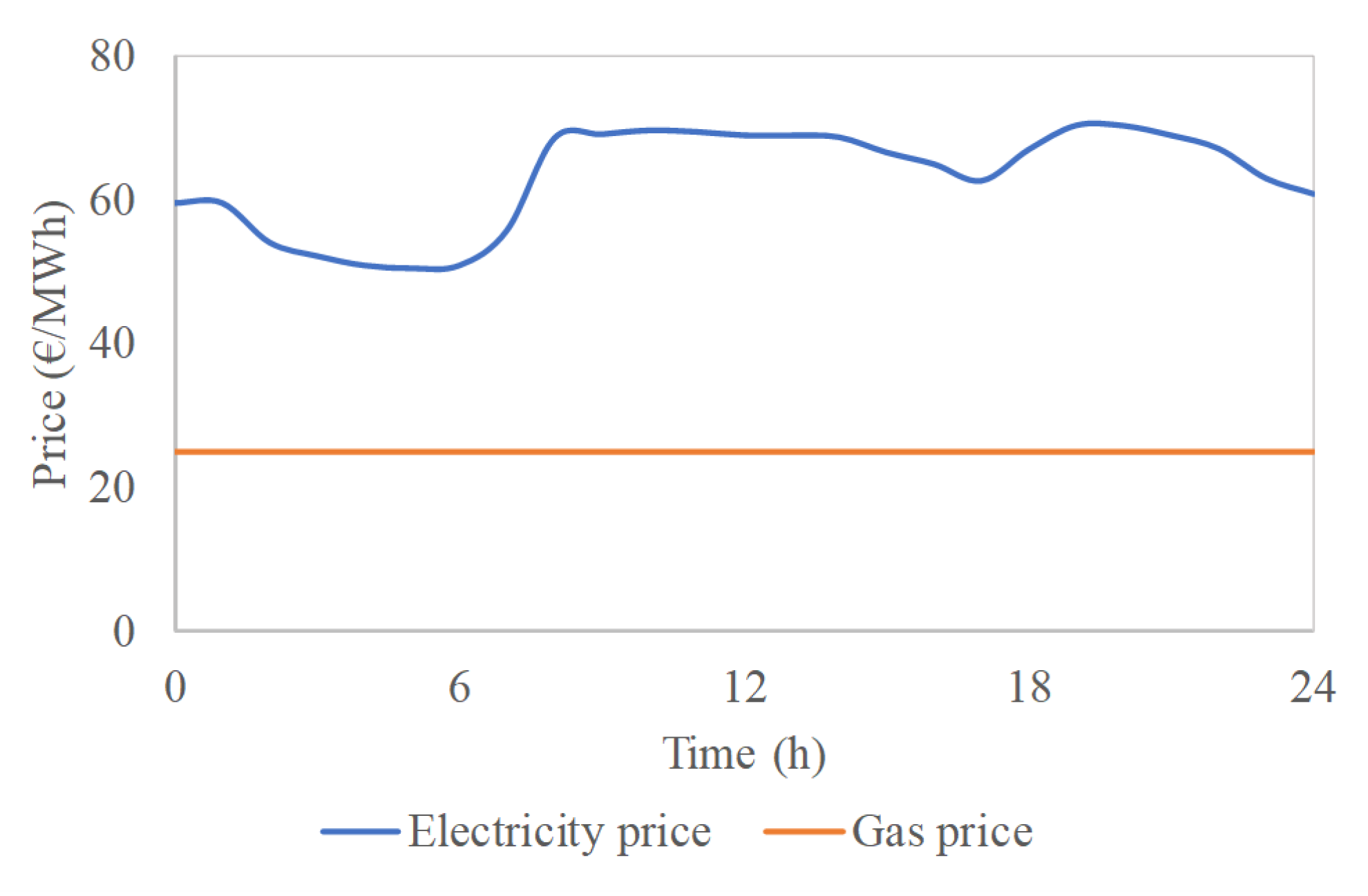
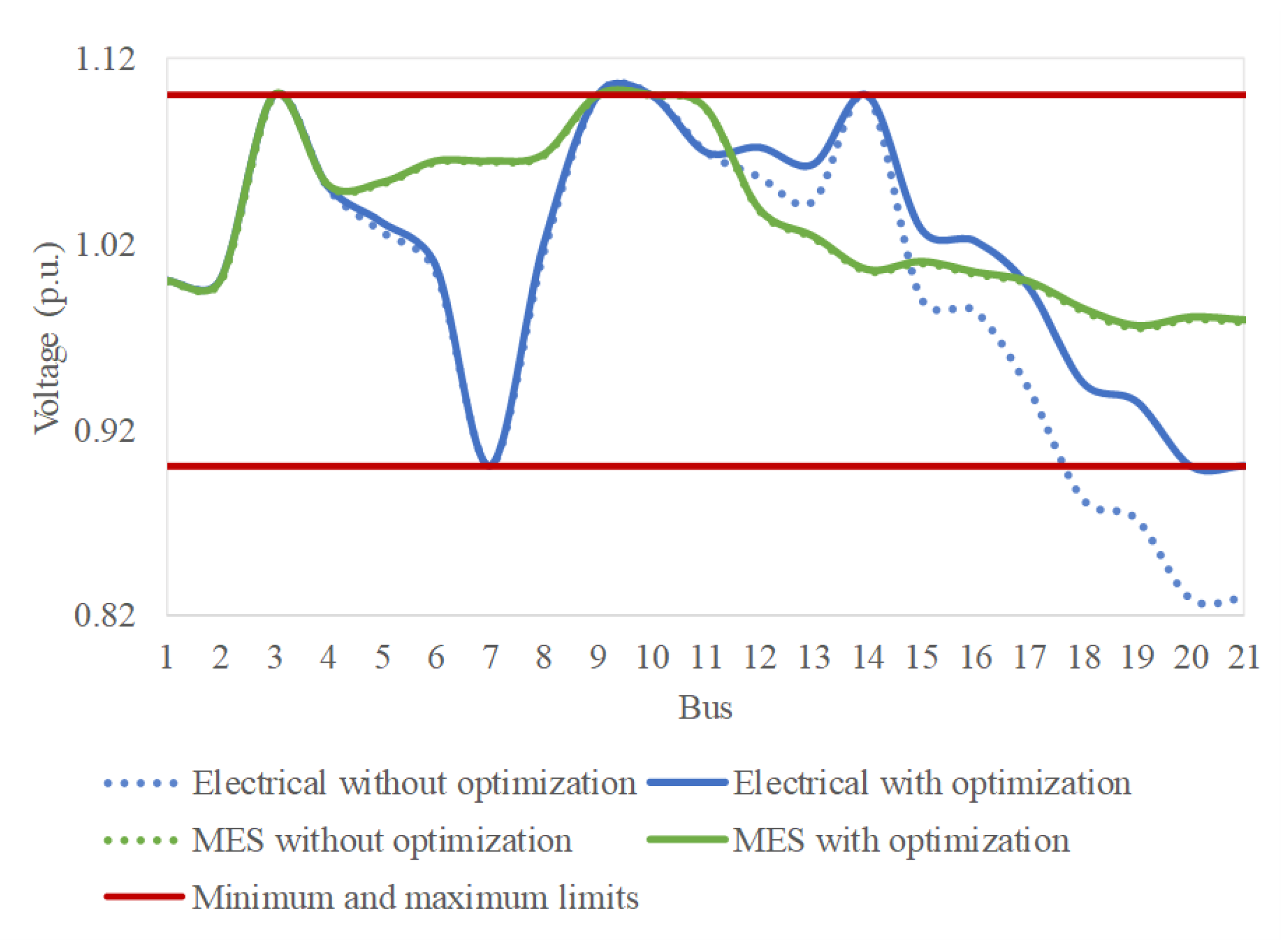
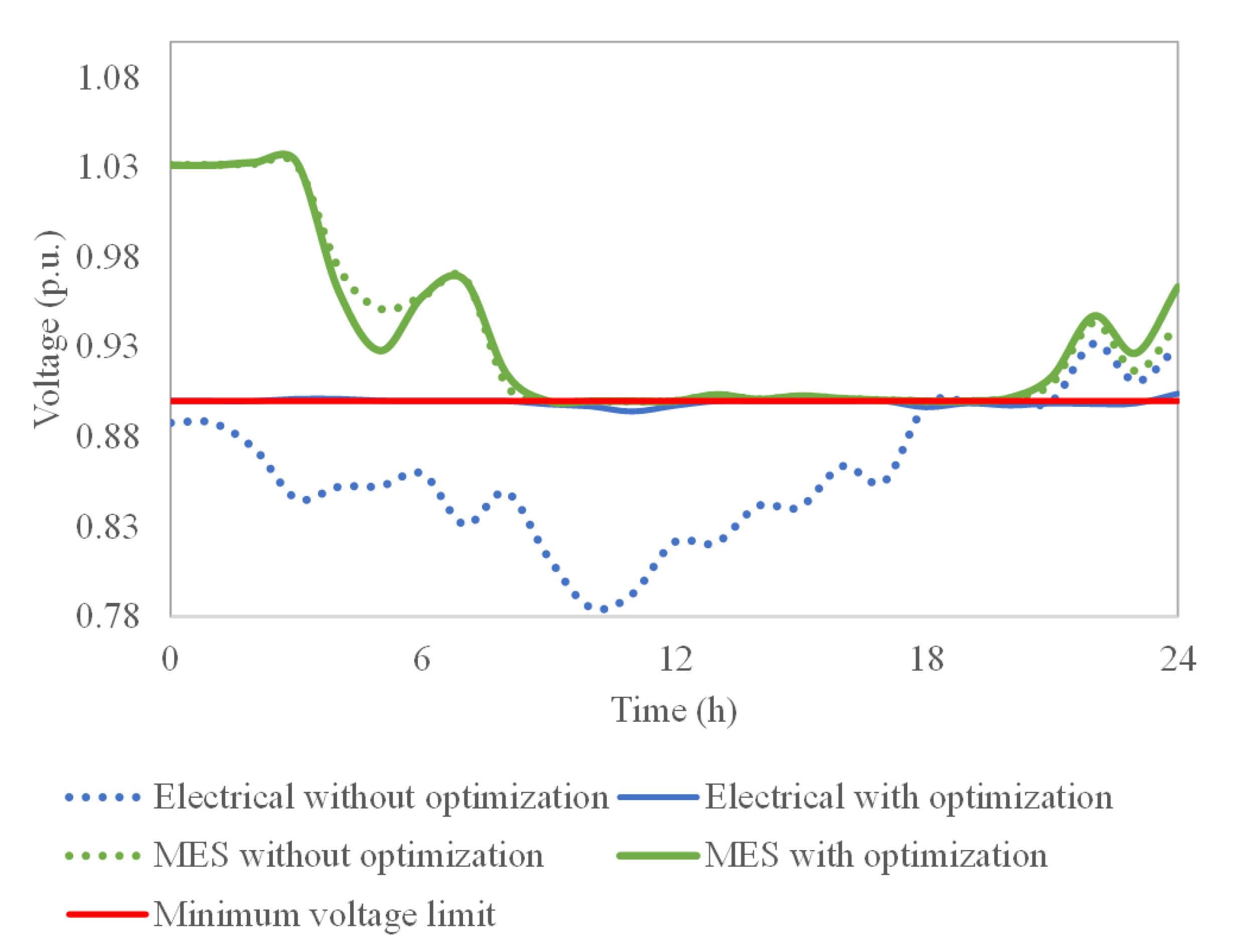
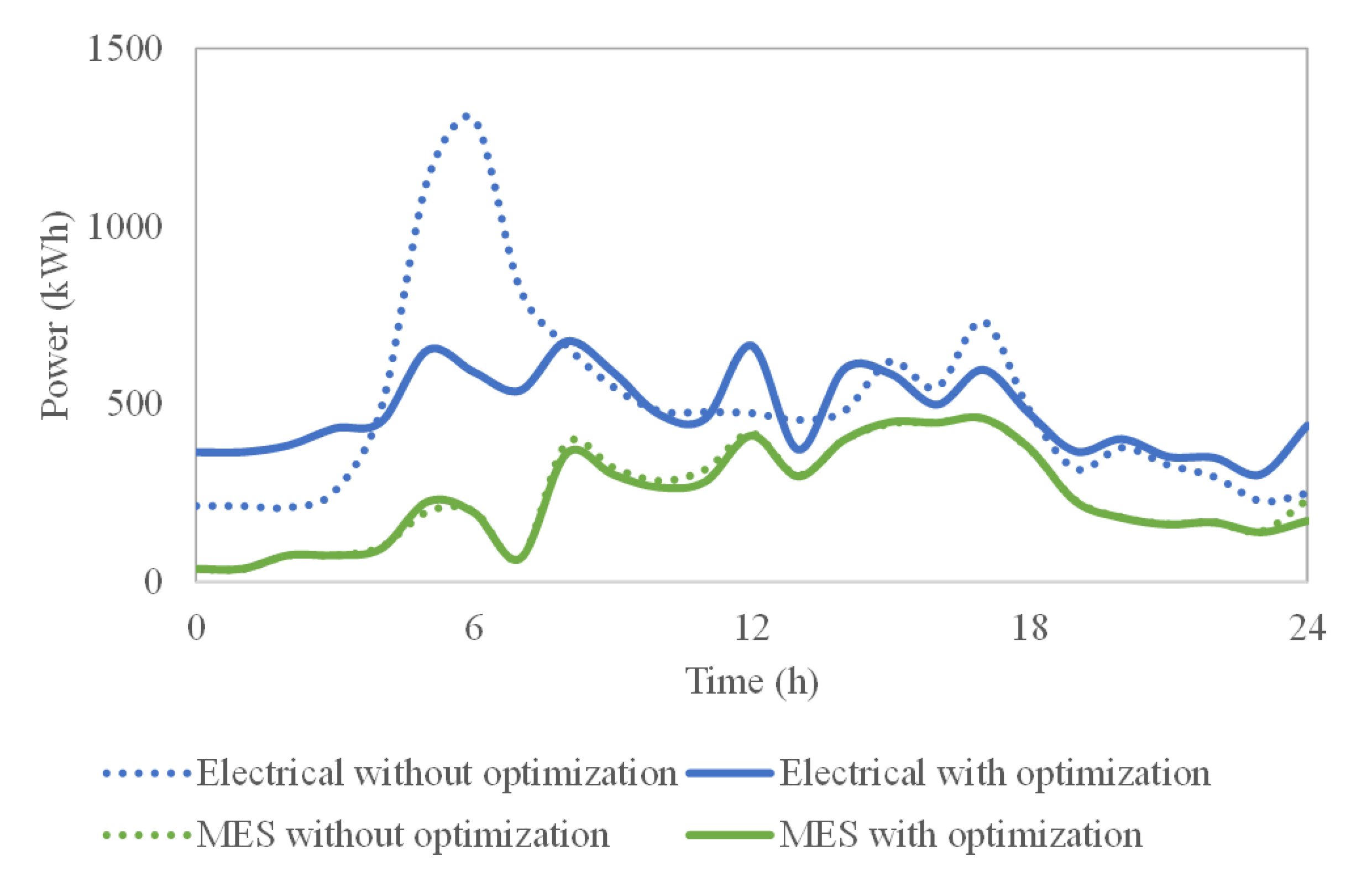
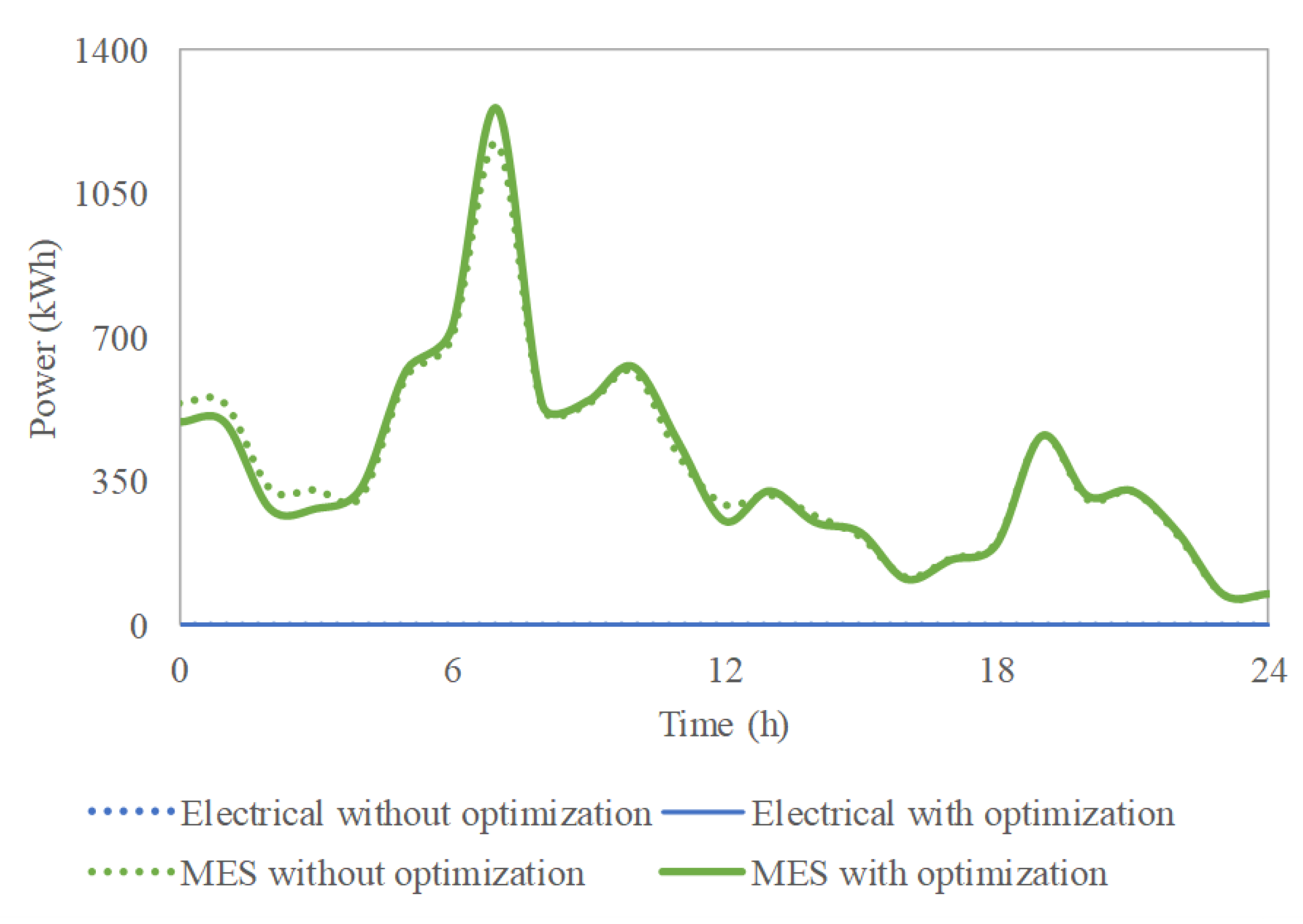

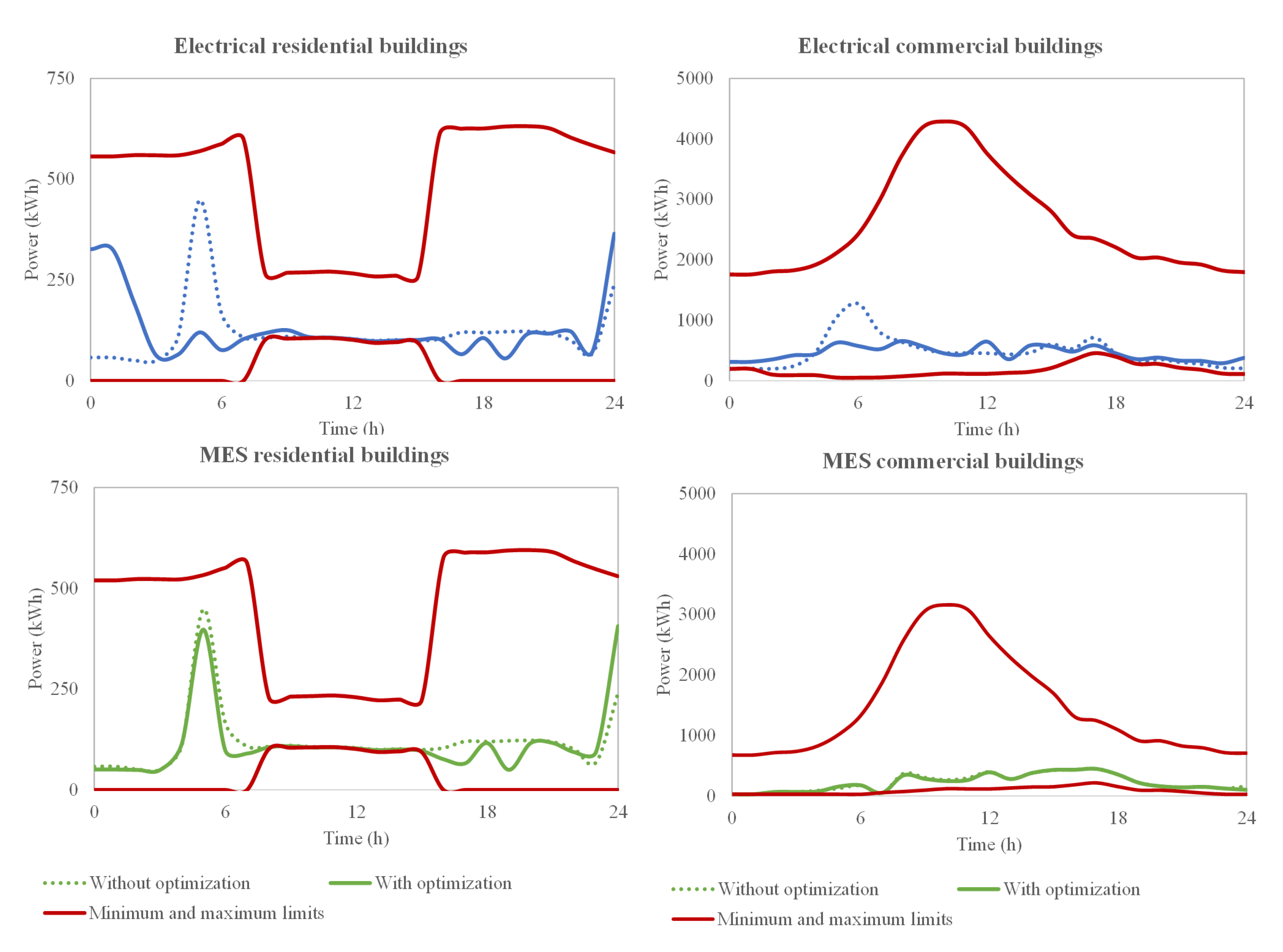

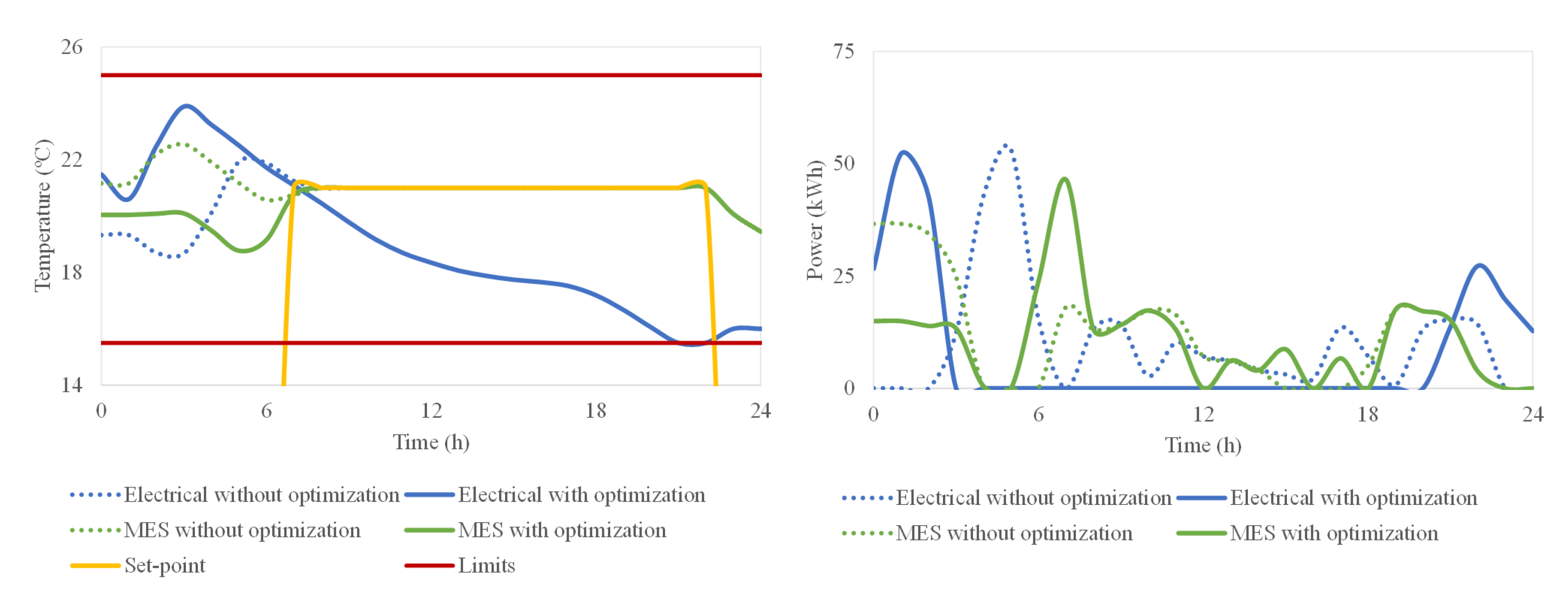
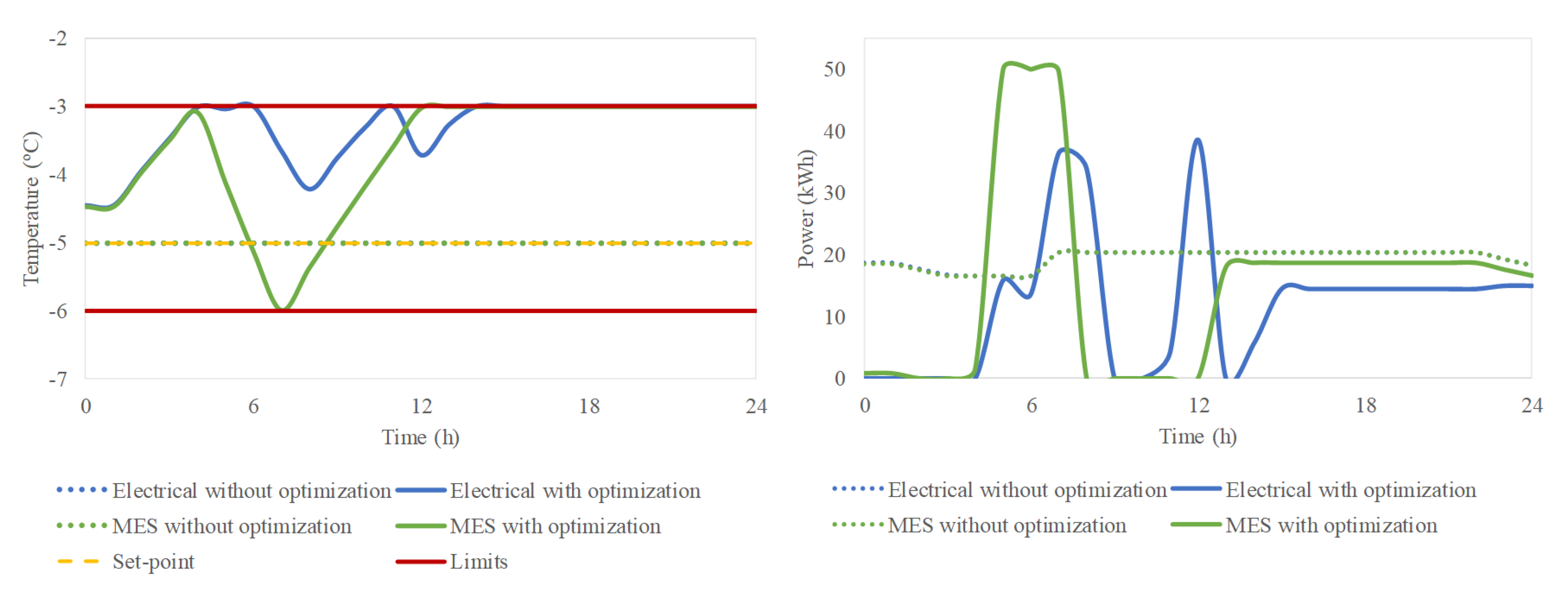
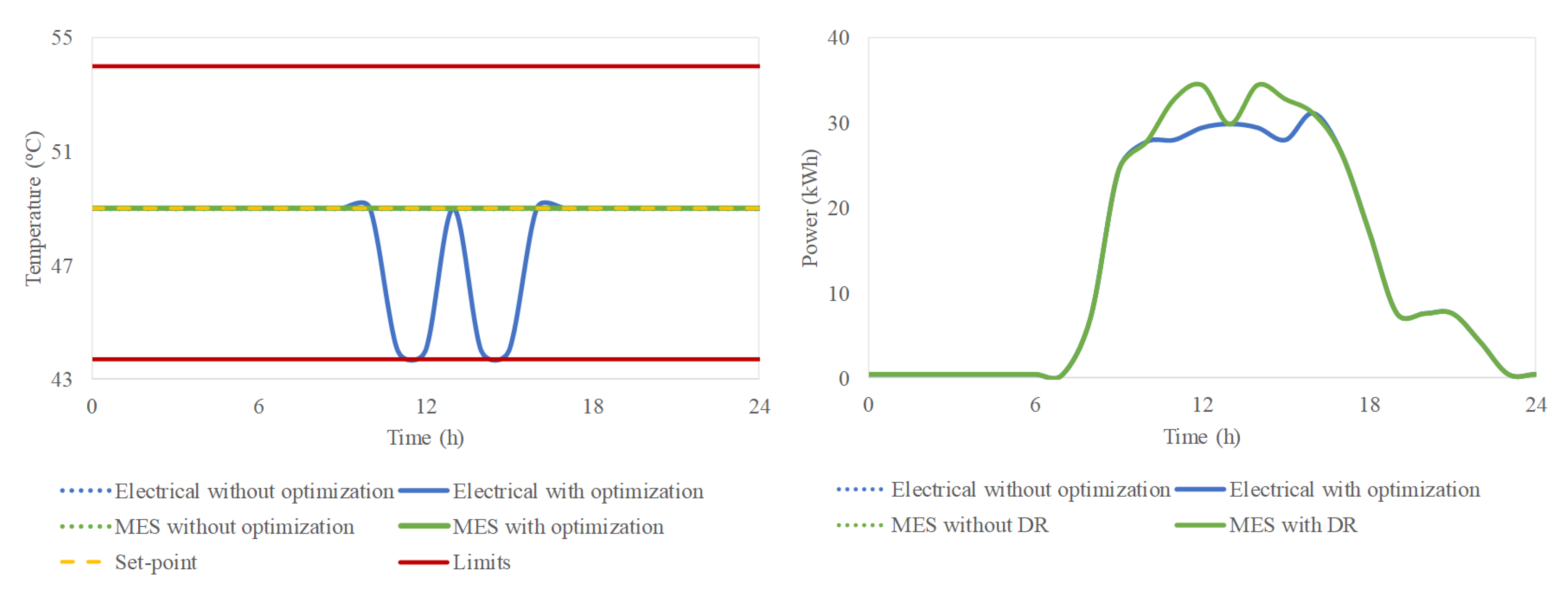

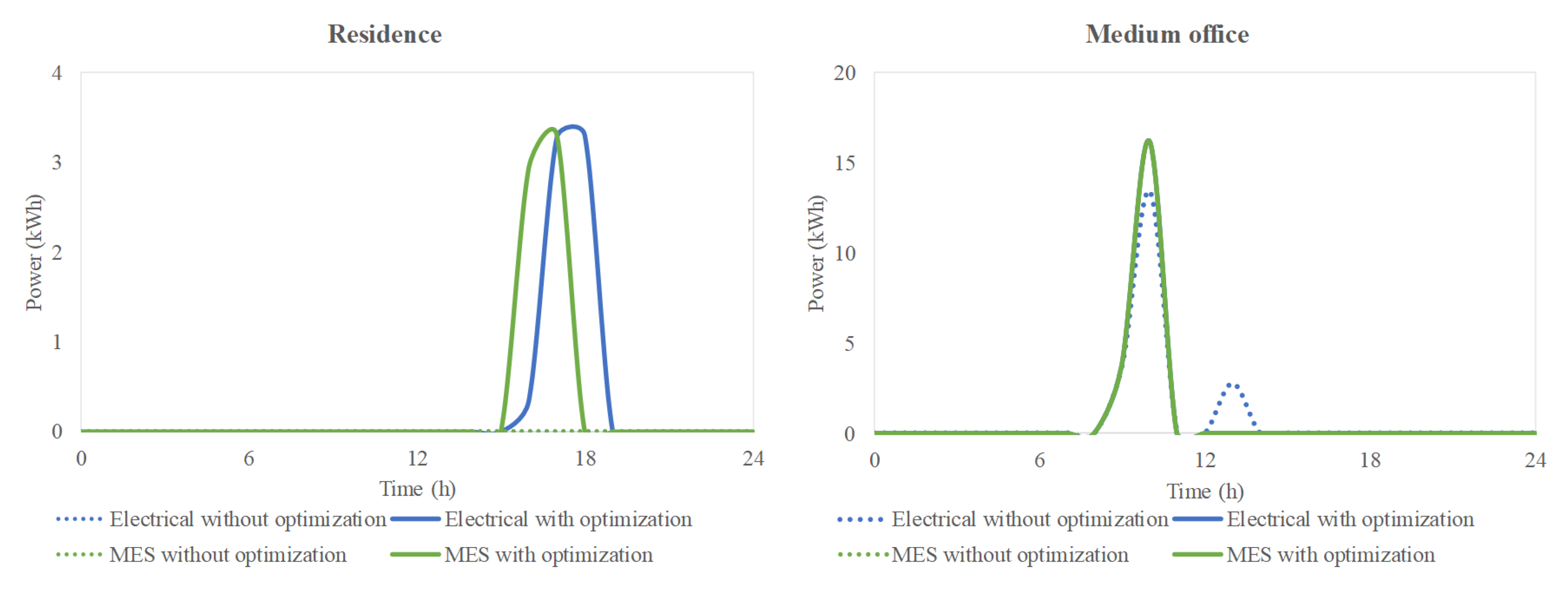

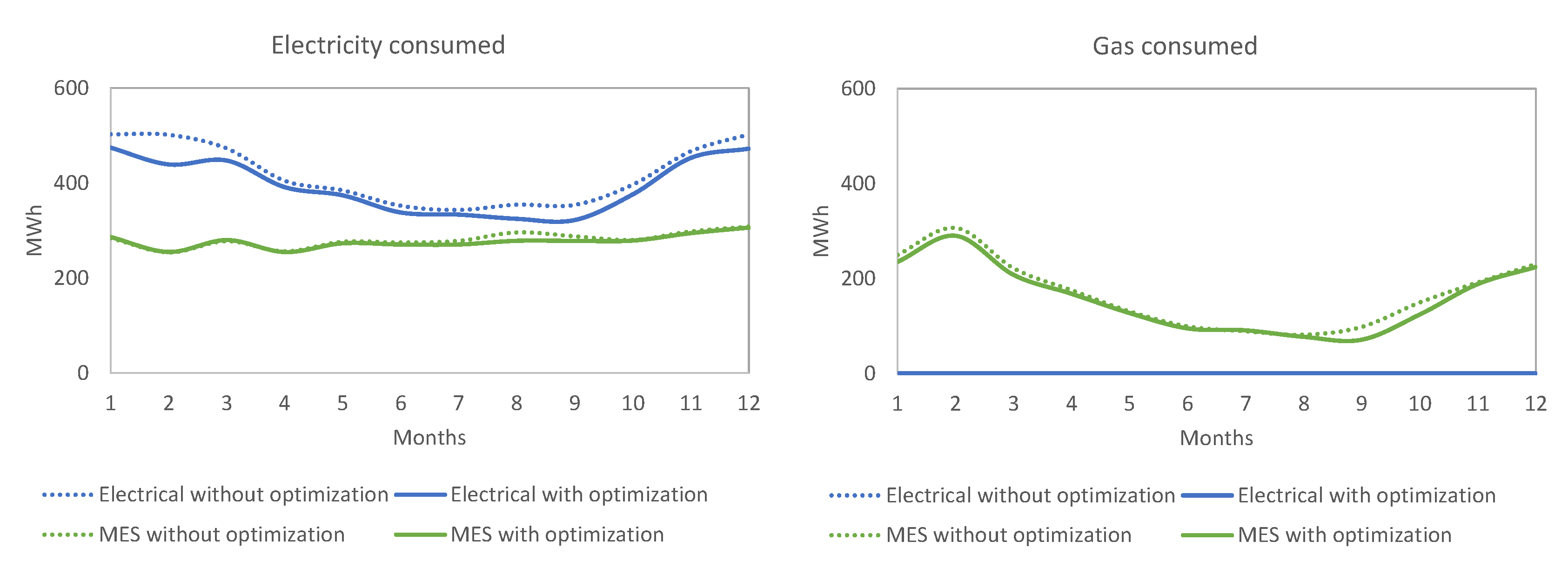
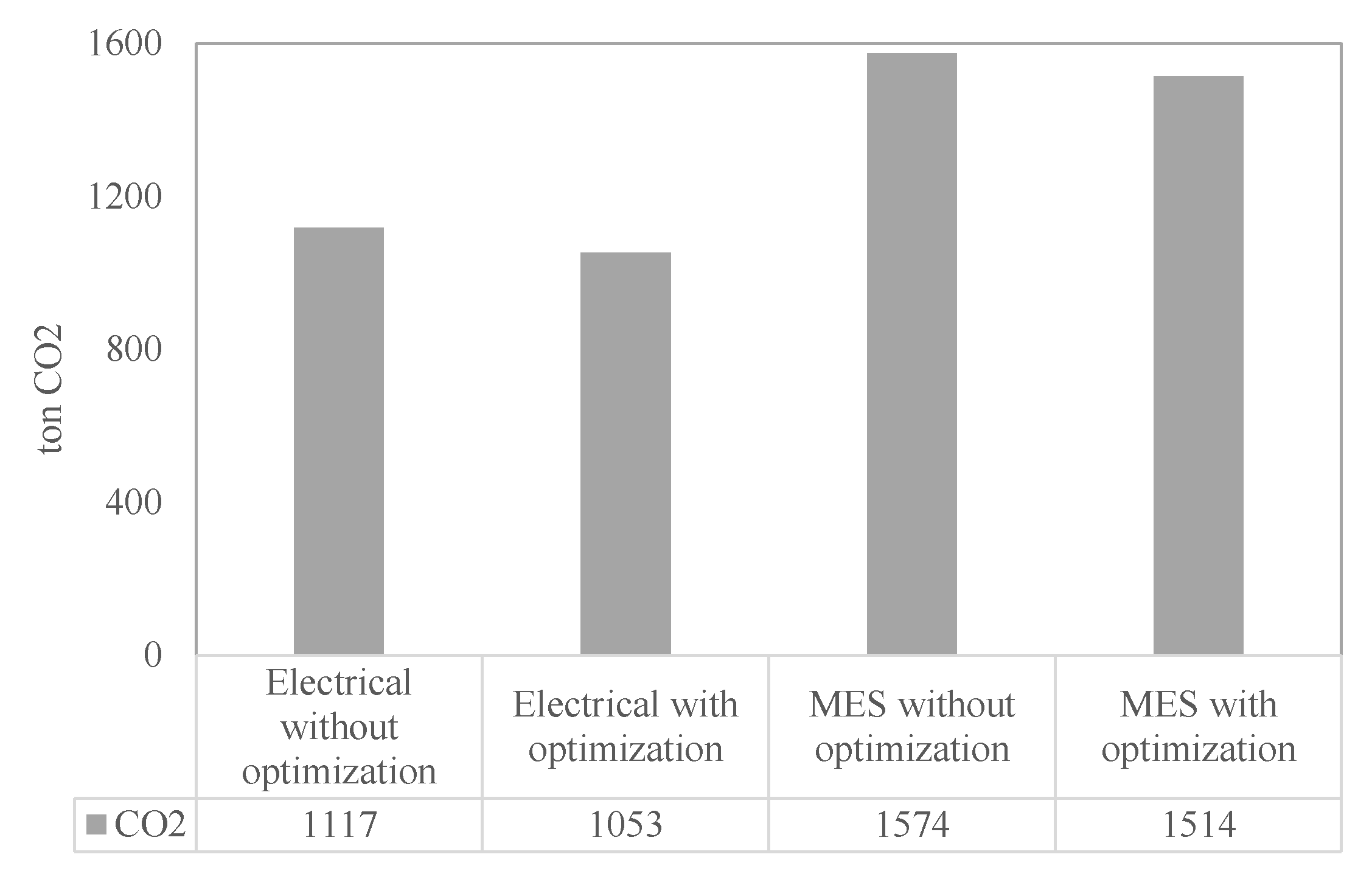
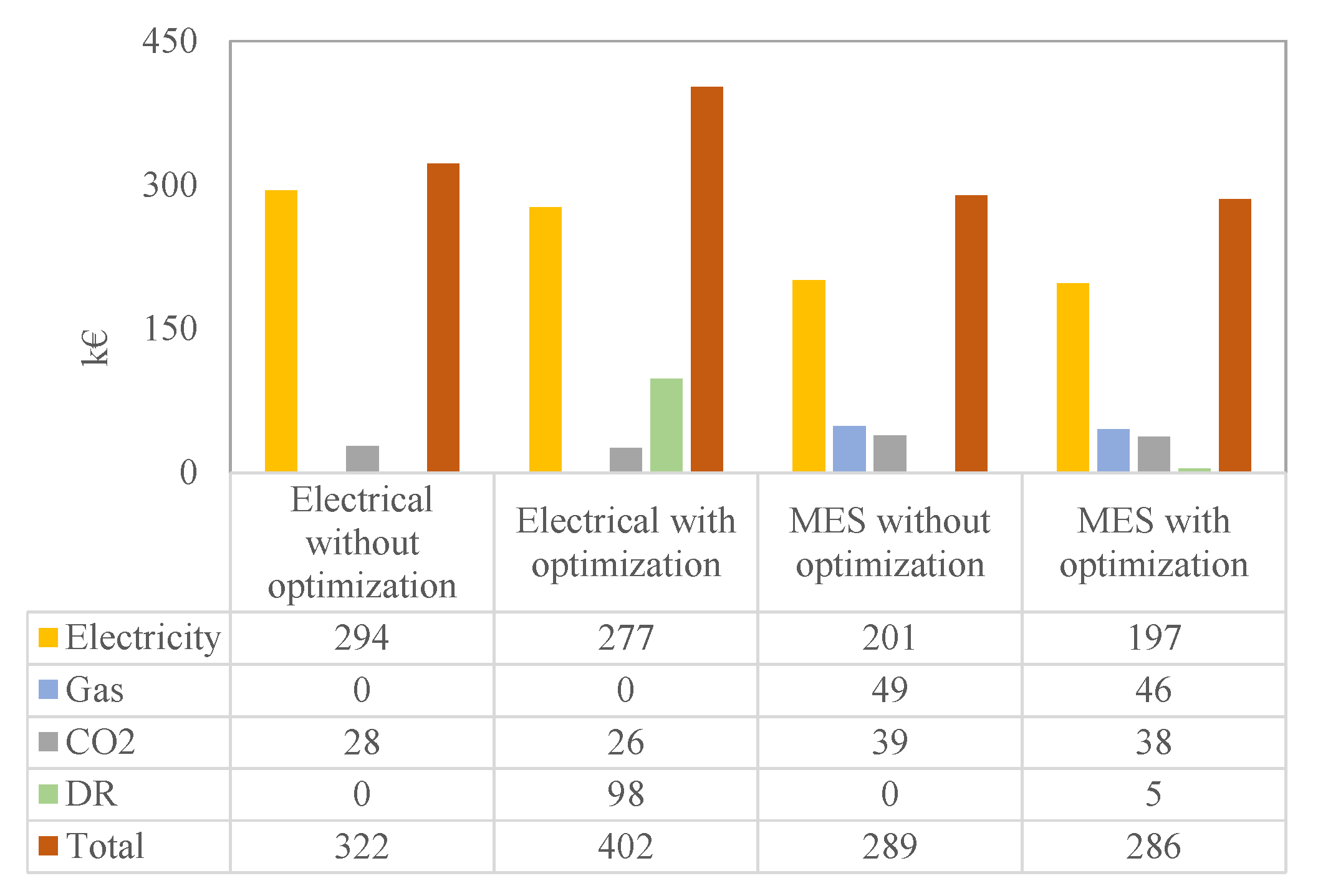
| Buildings | Bus | Number of Buildings | Other Loads |
|---|---|---|---|
| Residential | 5, 8, 9, 16, 18, 19 | 10, 5, 5, 5, 5, 5 | Refrigeration, Water |
| Small Office | 12, 14 | 5, 5 | Water |
| Medium Office | 3, 11 | 1, 1 | Water |
| Warehouse | 17, 21 | 1, 1 | - |
| Supermarket | 20 | 1 | Refrigeration, Water |
| Hospital | 7 | 1 | Water |
| Resources (kWh) | |||||||
|---|---|---|---|---|---|---|---|
| Buildings | Electrical | MES | |||||
| EB | HP | AC | GB | CHP | HP | AC | |
| Residential | 1 | 1 | 1 | 1 | - | 1 | 1 |
| Small Office | 10 | - | 5 | 5 | 10 | - | 5 |
| Medium Office | 100 | - | 75 | 50 | 100 | - | 75 |
| Warehouse | 50 | 50 | 50 | 50 | - | 50 | 50 |
| Supermarket | - | 100 | 50 | - | 50 | 50 | 50 |
| Hospital | 200 | - | 100 | 100 | 300 | - | 100 |
| Case | Electricity (MWh) | Gas (MWh) |
|---|---|---|
| Electrical without optimization | 5035 | 3 |
| Electrical with optimization | 4750 | 3 |
| MES without optimization | 3372 | 2028 |
| MES with optimization | 3328 | 1904 |
© 2020 by the authors. Licensee MDPI, Basel, Switzerland. This article is an open access article distributed under the terms and conditions of the Creative Commons Attribution (CC BY) license (http://creativecommons.org/licenses/by/4.0/).
Share and Cite
Coelho, A.; Soares, F.; Peças Lopes, J. Flexibility Assessment of Multi-Energy Residential and Commercial Buildings. Energies 2020, 13, 2704. https://doi.org/10.3390/en13112704
Coelho A, Soares F, Peças Lopes J. Flexibility Assessment of Multi-Energy Residential and Commercial Buildings. Energies. 2020; 13(11):2704. https://doi.org/10.3390/en13112704
Chicago/Turabian StyleCoelho, António, Filipe Soares, and João Peças Lopes. 2020. "Flexibility Assessment of Multi-Energy Residential and Commercial Buildings" Energies 13, no. 11: 2704. https://doi.org/10.3390/en13112704
APA StyleCoelho, A., Soares, F., & Peças Lopes, J. (2020). Flexibility Assessment of Multi-Energy Residential and Commercial Buildings. Energies, 13(11), 2704. https://doi.org/10.3390/en13112704







